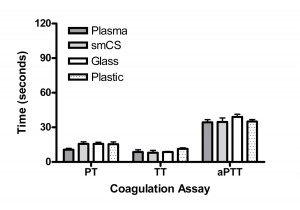Canadian Health Care Mall: The aPTT and dose of heparin
The aPTT should be measured approximately 6 h after the bolus dose of heparin, and the continuous IV dose should be adjusted according to the result. Various heparin dose-adjustment nomograms have been developed (Tables 4 and 5), but none are applicable to all aPTT reagents, and, for the reasons discussed above, the therapeutic range should be adapted to the responsiveness of the reagent used. 
Such problems with standardizing APTT monitoring have been highlighted in a recent review that examined the methodological quality of heparin administration in clinical trials comparing heparin and LMWH for the treatment of venous thrombosis. Of the 16 studies that met the inclusion criteria, only 3 used a properly validated aPTT therapeutic range to make heparin dose adjustments. Eleven studies used aPTT ranges that included values of 1.5 times the control value, which is invariably associated with subtherapeutic heparin levels when modern thromboplastin reagents are used, and 7 studies reported that the steady-state dose of heparin was < 30,000 U per 24 h after adjustment based on aPTT measurement results. Thus, the true efficacy of heparin in clinical trials of venous thromboembolism has likely been underestimated because most of the studies used unvalidated aPTT therapeutic ranges and therefore suboptimal heparin dosing.
It is possible that similar problems with heparin monitoring could explain the results of studies that have reported that the aPTT is not a good measure of heparin efficacy in patients with acute MI who were treated with thrombolytic therapy. The studies that provide the foundation for recommendations for UFH use in coronary thrombosis did not calibrate their therapeutic aPTT ranges by anti-factor Xa assays. Therefore, it is difficult to accurately reproduce the UFH dose adjustments used in other institutions. Simply generalizing aPTT therapeutic ranges would guarantee systematic errors in heparin administration in institutions with different thromboplastin reagents.
CHCM consensus group in recommending against the generalized use of a fixed aPTT therapeutic range such as 1.5 to 2.5 times the control value. Instead, we recommend that the therapeutic aPTT range be calibrated specifically for each reagent lot/coagulometer by determining the aPTT values that correlate with therapeutic heparin levels (equivalent to 0.3 to 0.7 IU/mL by factor Xa inhibition for the treatment of venous throm.
Table 1—Representative aPTT Therapeutic Ranges for Various Modern Thromboplastin Reagents, Determined by Recommended Methodology
| Reagent | Therapeutic aPTT | Therapeutic aPTT ratio | Reference |
| Actin | 59-84 | 2.3-3.2t | 71 |
| 49-92 to 49-109! | 1.9-3.7 to 2.1-4.6! | 69 | |
| Actin FS | 60-85 | 1.8-2.5 | 67 |
| 66-109 | 2.2-3.6 | 70 | |
| 79-105 | 2.3-3.0 | 67 | |
| 64-112 | 2.2-3.9t | 77 | |
| 55-78 | 1.9-2.7t | 75 | |
| 81-185 | 2.6-6.0 | 79 | |
| 72-119 to 98-165! | 2.6-4.3 to 3.7-6.2! | 69 | |
| Actin FSL | 57-98 to 84-124! | 2.1-3.5 to 2.6-3.8! | 69 |
| IL Test§ | 71-96 | 2.3-3.1 | 80 |
| 49-109 to 63-101! | 1.7-3.8 to 1.9-3.3! | 69 | |
| Platelin L| | 75-105 | 2.8-3.9 | 78 |
| 64-106 | 2.3-3.9 | 76 | |
| 55-97 | 2.1-3.7t | 77 | |
| Syntasil | 70-158 | 2.0-4.5 | 79 |
| Thrombosil | 44-75 to 58-112! | 1.6-2.7 to 2.4-4.5! | 69 |






